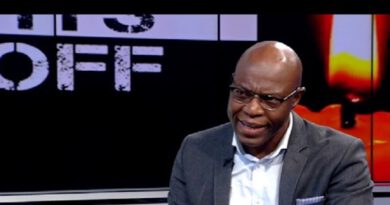R30bn lifeline for Denel, Sanral and Transnet
Almost R30 billion in conditional allocations in the current year to bail out Denel, the South African National Roads Agency (Sanral) and Transnet were proposed in the Medium-Term Budget Policy Statement (MTBPS) published on Wednesday.
In addition, government plans to take over a portion of Eskom’s R400 billion debt to enable the power utility to restructure, but says it is applying strict conditions to safeguard public money.
Click here for access to all our in-depth #MTBPS2022 coverage.
Net total adjustments to spending included in the 2022 Adjustments Appropriation Bill amount to R13 billion, with the largest adjustments – R6.3 billion or 49% – going mainly to the Department of Cooperative Governance and the Department of Transport for disaster management following the April flooding.
The Covid-19 social relief of distress grant, introduced in May 2020 as a temporary measure to support low-income households during the pandemic lockdowns, will be extended until March 2024. The MTBPS said 7.4 million people currently receive this grant.
Finance Minister Enoch Godongwana said any permanent extension or replacement of this grant will require a permanent increase in revenue, reductions in expenditure elsewhere – or a combination of the two.
Improved position
The MTBPS said the fiscal position has improved since the 2022 Budget as a result of better-than-expected revenue collection, with government using this revenue to increase spending in health, education and local government free basic services, infrastructure, and security and safety.
At the same time, it will narrow the budget deficit and address fiscal and economic risks posed by Denel, Sanral and Transnet.
Compared with the 2022 Budget, the gross tax revenue estimate for 2022/23 has been revised up by R83.5 billion, with government proposing a net addition of R37 billion compared with the 2022 Budget estimates to non-interest spending in 2022/23.
This consists of R54.1 billion in spending increases, partially offset by declared unspent funds, projected underspending and contingency reserve drawdowns.
Eskom
The MTBPS said government plans to provide debt relief to Eskom as part of a comprehensive approach to address the utility’s challenges, because the power utility does not generate sufficient revenues or control its costs.
It highlighted that Eskom is the biggest known risk to the economy and public finances and that the debt relief is aimed at ensuring the utility’s long-term financial viability.
“A lower debt burden will enable Eskom to implement a viable unbundling process and make resources available for investment in critical electricity supply and transmission infrastructure,” it said.
Godongwana said that while the selection of the relevant debt instruments and the method of effecting the relief is still to be determined, “the quantum is expected to be between one-third and two-thirds of Eskom’s current debt”.
“The debt takeover, once finalised, together with other reforms, will ensure that Eskom is financially sustainable.
“The programme will allow Eskom to focus on plant performance and capital investment and ensure it no longer relies on government bailouts,” he said.
Godongwana said the programme will include strict conditions required of Eskom, and other stakeholders, before and during the debt transfer.
“The conditions will be informed by a Treasury-led independent review of Eskom’s operations, in particular the performance of its generation fleet,” he said.
The MTBPS said measures to deal with Eskom’s structural challenges by managing its costs include: addressing arrears due to the utility, providing greater clarity and transparency in tariff pricing, and timeous execution of measures to address the sustainability of newly unbundled businesses.
Read: Eskom splits off transmission division
Godongwana said further details on the programme will be finalised following consultations with all relevant stakeholders and will be announced in the 2023 Budget.
A Treasury official said it was not possible to comment on the quantum of the debt relief programme because it is dependent on a number of factors, including Eskom’s tariff applications to the National Energy Regulator (Nersa).
The MTBPS stressed that debt relief alone will not solve Eskom’s problems and this measure is part of a comprehensive approach.
“While the utility has made progress in unbundling, which remains critical to its long-term sustainability, several underlying challenges must be addressed,” it said.
The government in 2019 announced a R230 billion support package for Eskom to remain financially viable.
To date, R140 billion of this package has been disbursed. In addition, Eskom had used R323.9 billion of its R350 billion government guarantee facility as at 30 June 2022.
The MTBPS said government’s guarantee exposure increased from R567 billion in 2020/21 to R594 billion as at 31 March 2022, driven largely by further drawdowns by Eskom, which accounts for 78% of guarantees to state-owned companies.
It added that independent power producer programme guarantees increased from R176.7 billion to R191.2 billion with the signing of additional contracts.
Three other important enablers of economic growth
In regard to the allocations to Sanral, Transnet and Denel, the MTBPS said all three companies are important enablers of economic growth, but face near-term challenges that require immediate injections of funds.
It said:
- R23.7 billion is allocated to Sanral to pay off government-guaranteed debt, but this allocation is conditional on a solution to Phase 1 of the Gauteng Freeway Improvement Project (GFIP);
- R5.8 billion is allocated to Transnet, half of which is shifted funds to repair infrastructure damaged by the recent floods and the balance to increase locomotive capacity; and
- R204.7 million will be allocated to Denel to reduce contingent liabilities arising from its weak financial position and – if set conditions are met – R3.4 billion to complete its turnaround plan.
The MTBPS said government continues to review the value created by state-owned companies as part of evaluating whether they can be run sustainably.
It said the Presidential State-Owned Enterprises Council has developed a draft framework to guide decisions on disposing of and retaining state-owned companies.
“To complement this work, the National Treasury has begun developing a state-owned companies funding framework, which will be finalised in 2022/23,” it said.
Source: moneyweb.co.za


